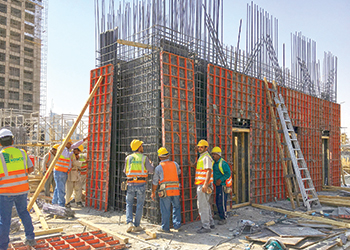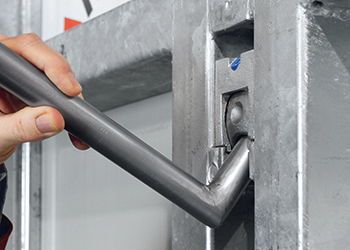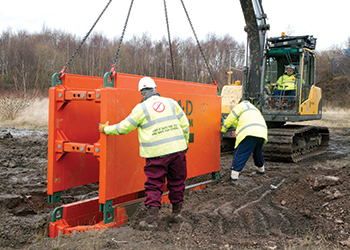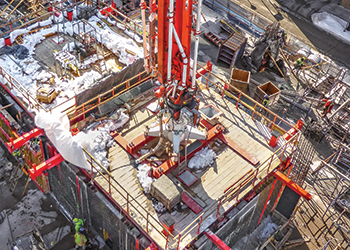
 The new Meva Mammut XT wall formwork system ... offers three tying methods in one system.
The new Meva Mammut XT wall formwork system ... offers three tying methods in one system.
Meva this year introduced a new wall formwork system for civil engineering and architectural construction that offers single and two-sided tie technology.
The Mammut XT has more options, requires fewer parts for tying, and requires less labour thus saving time and cost while focusing on improved safety and easy handling. It is based on the successful heavy-duty Mammut 350 system and its 100 kN per sq m load capacity. The tie-hole pattern on the inside of the panels delivers a completely symmetrical imprint in the concrete – with every panel. The 350, 300, 250 and 125 cm high and 250, 125, 100, 75, 50 and 25 cm wide panels allow for a formwork set-up in width increments of 25 cm.
“Corners for any wall thickness are simple and quick to achieve in 5-cm steps with only three outside corners (lengths 0, 10 and 15 cm) and two inside corners with lengths of 35 and 40 cm. Fewer parts mean less effort, easier planning and simpler logistics,” says a spokesman for the German formwork specialist.
Commenting on the new product, he says: “Tying from one side only can be an advantage in difficult pours and for long, high walls. Without requiring additions, conversions or modifications, the new Mammut XT system allows the integrated XT tie hole to be set to more than one tying methods.”
The system can be tied from one side only using DW 20 tie-rods and sleeves and using taper ties without sleeves; or from both sides using DW 20 (or DW 15) tie rods and sleeves.
The system’s new XT tie hole is completely integrated in the panel frame and set to the desired tying method with a single movement. There are no protruding or loose parts. Panels can be stacked normally, again reducing time and effort in handling and during transport, the spokesman says.
 |
The XT tie hole is built into the panel frame. |
The XT tie rod and articulated flange nut form only one single part. This saves the flange nuts on one side of the formwork set-up completely and reduces the number of parts required for tying by 50 per cent, he adds.
The Mammut XT offers the option of tying from one side using taper ties without sleeves – a method well-proven and common particularly in North America – in addition to the proven DW 20 (or DW 15) tie rod with plastic sleeve. Here, too, the site benefits from the articulated flange nut and tie rod being one part.
With all these features, no additions, conversions or modifications are needed when switching from one sided to two-sided tying. There is no difference between the two sides of the formwork set-up and thus no extra effort in preparing or handling additional parts, the spokesman says.
Handling and logistics are simplified even more by the system’s park position tie rod holder. “Thus, the tie rods always travel with their panels to the next pour. There is no need to transport and store them and no time is wasted by looking for them. The park position tie rod holder is plugged into the panel’s multi-function profile with a pin – exactly like the walkway bracket plugs into the multi-function profile. This works with panels in vertical and horizontal position. The tie rod holder secures automatically and nothing can slip out,” the spokesman explains.
The panels of the new Mammut XT system are equipped with clamp holders at the standard clamp positions.
“After stripping, the clamp is attached to the clamp holder and secured with just one hammer blow. When moving the panels from one pour to the next, the correct number of clamps travel with them; they are always at hand and ready for the next assembly. No storage and separate transport is required – simple and time-saving logistics and handling are the benefits,” says the spokesman.





















_0001.jpg)


.jpg)
















.jpg)








.jpg)





